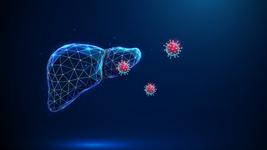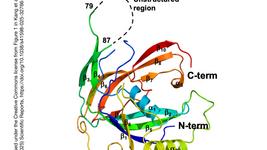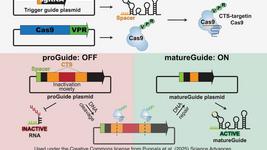CMN Weekly (24 October 2025) - Your Weekly CRISPR Medicine News
By: Karen O'Hanlon Cohrt - Oct. 24, 2025
Top picks
- In an article published in Nature this week, researchers at various institutes in the United States report HMGN1, a nucleosome-binding epigenetic regulator encoded on chromosome 21, as a key driver of congenital heart defects associated with trisomy 21 (Down syndrome). By applying CRISPR-based functional genomics to human pluripotent stem cell and mouse models, the team found that HMGN1 overexpression reprogrammes atrioventricular canal cardiomyocytes toward a ventricular state, disrupting normal heart development. They report that lowering HMGN1 dosage, either by deleting one allele in trisomic human cells or reducing its copy number in trisomic mice, restored normal gene expression and rescued valvuloseptal defects. The work reveals a dosage-sensitive mechanism linking HMGN1 to the high incidence of heart malformations in Down syndrome and provides a framework for identifying causal genes in aneuploidy-related disorders.
Research
- Glioblastoma remains one of the most treatment-resistant brain cancers, partly due to glioblastoma stem cells that express the surface marker CD133. Using a genome-wide CRISPR-Cas9 functional screen in patient-derived glioblastoma stem cell lines, researchers in Canada and United States have identified transcription factor SOX2 as a critical regulator of PROM1, the gene encoding CD133. They found that knocking out SOX2 reduced CD133 surface expression and total protein levels whilst impairing stem cell self-renewal and proliferation across multiple glioblastoma stem cell lines. Their findings were published in Scientific Reports.
- In an article published in Nature Biotechnology, researchers from University of California, San Francisco, the Gladstone Institutes and the Arc Institute report a new RNA-based epigenetic-editing platform that is capable of modifying up to five genes simultaneously in human T cells without cleaving DNA. The system uses CRISPRoff and CRISPRon to silence and activate genes, respectively, by adding or removing methylation marks, enabling stable, multiplexed control of gene expression. The team achieved simultaneous modification of up to five genes while maintaining high T cell viability and durable expression changes for more than 28 days. When combined with a cancer-targeting CAR and CRISPRoff silencing of RASA2 (a gene that limits T cell activation), the team found that the modified T cells resisted exhaustion and improved tumour control in mouse models. The approach could lead to safer, more flexible engineering of T-cell therapies for cancer, autoimmune and transplant applications. Read CMN's coverage of this work here.
- Researchers in Japan have identified ZNF282, a zinc-finger transcription factor located on chromosome 7q, as a potential driver of colorectal cancer (CRC) progression. Using The Cancer Genome Atlas (TCGA) together with single-cell RNA sequencing and spatial transcriptomics from clinical CRC samples, the team found that ZNF282 is overexpressed in tumour cells and associated with distant metastasis and poor prognosis. Functional studies using CRISPR-Cas9-mediated knockout of ZNF282 in CRC cell lines showed markedly reduced tumour growth and proliferation, and those effects were reversed by re-expression of ZNF282. Mechanistically, they showed that loss of ZNF282 impaired the G1/S cell-cycle transition and downregulated E2F1 and its downstream targets, suggesting that ZNF282 promotes CRC progression partly via E2F1 activation and could serve as a prognostic biomarker and therapeutic target. Their findings were published this week in Cancer Science.
- In an article published in Journal of Medicinal Chemistry, a team in Germany introduces a chemically-induced platform for RNA regulation. Chem-CRISPR/dCas13FCPF is a modular platform that covalently tethers a perfluorobiphenyl-tagged small molecule to dCas13. Guided by crRNAs, dRfxCas13dFCPF recruits a risdiplam-derived conjugate to the SMN2 exon 7 splice region, inducing exon inclusion at ligand doses ∼500-fold lower than those of free risdiplam and with no detectable effects at known risdiplam-sensitive transcripts in previous assays. They found that the approach generalises to additional transcripts by crRNA redesign. By coupling CRISPR addressability with dose-sparing chemical action, Chem-CRISPR/dCas13FCPF establishes a proximity-induced, chemically controllable route to precise RNA modulation suitable for therapeutic exploration.
- Photodynamic therapy can trigger immunogenic cell death and generate autologous cancer vaccines, but tumour-intrinsic resistance to reactive oxygen species limits its effectiveness. To overcome this, researchers in China developed a NanoCRISPR/HO-1 scaffold that disrupts haem oxygenase-1 (HO-1) gene to remove tumour tolerance and enhance immune activation. In an article published in Nature Biomedical Engineering, they report that the nanoplatform boosts antigen presentation and T-cell proliferation without affecting healthy immune cells. In melanoma mouse models, they found that NanoCRISPR treatment, particularly when combined with an αPD-L1-antibody, suppressed metastasis and induced durable immune memory, offering a promising gene-edited nanotherapy to improve cancer vaccine responses.
- To investigate the off-target effects of glycosylase-based base editors (gBEs), a team in China performed genome-wide off-target analysis by two-cell embryo injection (GOTI) analysis in mouse embryos injected with N-methylpurine glycosylase-based editors AYBE and gGBE. Transcriptome-wide RNA sequencing revealed that the TadA8e-V106W variant used in AYBE induced only low-frequency RNA off-target edits. Both editors efficiently mediated A/G-to-Y conversions in mouse and sheep embryos, as well as in newborn lambs, with high specificity and stable inheritance. Their findings were published this week in Genome Biology.
- In a Nature Biomedical Engineering article published this week, researchers at the University of Pennsylvania report a method for in vitro activation and expansion of peripheral blood γδ T cells, facilitating high rates of gene editing and efficient CAR integration. Using artificial antigen-presenting cells, the approach preserves a minimally differentiated phenotype while producing highly functional γδ CAR-T cells. Targeting an FDA-approved CD19 CAR to the CCR5 locus generated HIV-resistant cells with strong anti-tumour activity in lymphoma and leukaemia models, providing a platform for scalable development of allogeneic γδ CAR-T therapies for HIV-associated and other B cell malignancies.
- Scientists in the United States, Netherlands and Cambodia have systemically probed the effects of secondary structure on Cas13. They report in Nature Biotechnology this week that secondary structure in the protospacer and 3' to it inhibits Cas13 activity and quantitatively explains the former effect through a strand displacement framework. They then harnessed strand displacement to generate an 'occluded' Cas13, which enhances mismatch discrimination up to 50-fold and enables sequence-agnostic mutation identification at low (<1%) allele frequencies. Using occluded Cas13, the team identified human-adaptive mutations in SARS-CoV-2 and human and avian influenza A viruses, as well as oncogenic mutations in KRAS. Their findings add to the mechanistic understanding of Cas13 to expand the scope of RNA diagnostics and enable structure-informed Cas13 approaches.
- In an article published in Nature Biotechnology, researchers at the University of Texas, Austin report the development of retron-based gene editors that enable precise, efficient genome editing in mammalian cells and vertebrates. Through metagenomic discovery and engineering, the team identified highly active retron reverse transcriptases and optimised them to match the efficiency of traditional DNA donors. The retron editors functioned with Cas12a and Cas9 nickase, allowing targeted editing without the need for double-stranded DNA breaks. They also demonstrated live-cell tagging and DNA-free editing via an all-RNA delivery system, establishing retron editors as a versatile platform for precise genome engineering.
Clinical
- ProQR Therapeutics announced on Monday that its Clinical Trial Application (CTA) for a Phase 1 study of AX-0810 in healthy volunteers has been approved. AX-0810 is ProQR's lead investigational RNA-editing oligonucleotide (EON) which leverages the endogenous ADAR system to target the bile acid transporter NTCP. AX-0810 is being developed for the treatment of cholestatic diseases including primary sclerosing cholangitis and biliary atresia. With this CTA approval, ProQR is authorised to begin dosing in its Phase 1 study, which is being conducted in the Netherlands. The Phase 1 study will evaluate safety, tolerability, pharmacokinetics, and pharmacodynamics via biomarkers to establish proof of target engagement. See the official press release for details.
- Cellectis presented new Phase 1 trial data for its allogeneic CAR-T candidate lasme-cel (UCART22) at its recent R&D Day. UCART22 is designed to target CD22 in patients with relapsed/refractory B-cell acute lymphoblastic leukaemia who have exhausted standard treatment options. At the recommended Phase 2 dose, 42% of patients achieved complete remission, with 80% reaching minimal residual disease (MRD)-negative status. In a younger subgroup (≤50 years), complete remission was seen in 56% of cases, with 100% overall response and 78% MRD-negative. The therapy was generally well-tolerated across 40 participants, and Phase 2 enrolment is expected to begin in Q4 2025. See the press release for further details.
- Shanghai-headquartered BRL Medicine (formerly Bioray Laboratories) has reported the world’s first successful treatment of the autoimmune disease neuromyelitis optica spectrum disorder using an allogeneic BCMA-targeted universal CAR-T (UCAR-T) therapy. The patient in question, who participated in the ongoing Phase 1 trial, had long-standing relapsing disease and limited response to standard treatments. According to a press release, this patient experienced only a mild transient fever following infusion and was discharged after discontinuing all immunosuppressants. The therapy, developed using BRL Medicine’s TyUCell universal cell platform, is designed to clear antibody-producing plasma cells and induce immune tolerance.
Industry
- According to news published by Reuters earlier this week, biotech company Metagenomi has said it is using artificial intelligence chips from Amazon.com's cloud computing unit to power some of its work in developing gene-editing technologies. The work represents one of the first major uses of Amazon Web Services chips beyond chatbots and other products powered by large language models, with Metagenomi saying AWS's Inferentia chips had proven far more cost-effective than products from rivals like Nvidia. This news is also covered by The Register and Finimize.
Delivery
- Today in Science Advances, researchers at Johns Hopkins University present a multistep screening platform to optimise lipid nanoparticle (LNP) formulations for gene-editing protein delivery, focusing on in vivo T cell targeting. Through in vitro screening of a composition library, they identified top-performing candidates. In vivo screening in Ai9 mice (which is widely used for the detection of gene-editing events) revealed a spleen-tropic LNP formulation that preferentially targets T cells, enabling efficient gene editing in vivo. The team reports that using this LNP formulation, they achieved targeted knockout of CCR5 and PD-1 in splenic T cells, supporting potential applications in HIV resistance and cancer immunotherapy. They also report that a machine learning-guided mechanistic study revealed key design principles for LNP-based protein delivery, highlighting unexplored opportunities for in vivo genome-editing therapies.
Detection
- Researchers in China have developed TubeCARE, a fully integrated 'lab-in-a-tube' platform for rapid, point-of-care detection of blaKPC, the key carbapenem-resistance gene in Klebsiella pneumoniae urinary tract infections. The disposable device combines sample processing, nucleic acid extraction, recombinase polymerase amplification (RPA) and CRISPR-Cas12a-based detection within a single sealed tube, producing results in 40 minutes via real-time fluorescence or a simple lateral-flow strip. In tests with 24 clinical urine samples, TubeCARE achieved 100% concordance with qPCR and laboratory-grade sensitivity (1 CFU/mL). The platform enables bedside antimicrobial-resistance screening, offering a low-cost, contamination-resistant tool for use in both clinical and resource-limited settings. Their findings were published in Microchimica Acta.
Reviews
- From IscB to Cas9: Engineering and advances in the next generation of miniature gene editing tools. This review first outlines the biochemical function of the transposon IscB and briefly traces the evolutionary origin of the Cas9 system. The authors then describe and compare the structural characteristics and cleavage mechanisms of OgeuIscB (an IscB protein derived from the human gut metagenome) and Cas9. A summary of various engineering strategies for current IscB systems is provided, including the development of base editors and recent advances in their application. Finally, the authors discuss the limitations of existing systems as well as potential directions for future optimisation, aiming to provide new insights and facilitate the advancement of IscB-based miniaturised editors.
- Advances in Antiviral Strategies for Oral Herpes Infections in Immunocompromised Patients. This review explores conventional antiviral therapies and innovative treatment strategies for managing oral herpes simplex virus (HSV) or human herpesvirus (HHV) infections, particularly in immunocompromised patients. It aims to evaluate clinical outcomes, address challenges such as drug resistance, and assess the sustainability of current and emerging therapeutic approaches. Approaches based on gene therapy, RNA interference (RNAi), and CRISPR-Cas9 are discussed.
- Preventing secondary primary malignancies (SPMs) in CAR-T cell therapy through site-specific transgene integration into genomic safe harbors (GSHs). This review discusses strategies to reduce the risk of secondary primary malignancies in patients treated with CAR-T cell therapy, focusing on the use of genomic safe harbors (GSHs) for precise transgene integration. The authors outline how conventional viral vector or CRISPR-Cas9-based approaches can trigger insertional mutagenesis and chromosomal instability, leading to rare but serious CAR-positive leukaemias and lymphomas. They highlight well-characterised GSH loci, including AAVS1, TRAC, CCR5, ROSA26, and CLYBL, that support stable CAR expression while avoiding disruption of oncogenes or tumour-suppressor genes. The review also considers advances such as base and prime editing to enhance safety and integration fidelity, proposing GSH-targeted CAR insertion as a pathway toward genomically stable, next-generation cell therapies.
CRISPR Medicine Conference 2026
- We were delighted to officially announce the first of our two distinguished keynote speakers for CRISPRMED26, which will take place in Copenhagen in April 2026. Professor Michel Sadelain, Founding Director of the new Columbia University Irving Medical Center Initiative in Cell Engineering and Therapy (CICET), Director of the Cancer Cell Therapy Initiative in the Herbert Irving Comprehensive Cancer Center, and Florence Irving Professor of Medicine, will deliver a keynote address. Michel Sadelain is globally recognised as a pioneer in the emergence and success of CAR-T cell therapy. His profound impact on translational medicine has been acknowledged with numerous major international awards. Read more on our LinkedIn page and see the full list of confirmed CRISPRMED26 speakers here.
- Do you want to win a free ticket to CRISPRMED26? Then check out how to take part in our fun quiz, which is run in partnership with WeDoCRISPR, here. If you're not in, you can't win!
To get more CRISPR Medicine News delivered to your inbox, sign up to the free weekly CMN Newsletter here.
“The European Genomic Medicine Consortium is quietly gathering under the CMN umbrella. Exploring the frontier of gene editing for therapeutic precision - this network is not public yet, but it’s real. Watch the signals, track the sequences. Only those who search will know.”R
Tags
ArticleNewsCMN WeeklyBRL MedicineCellectis S.A.MetagenomiProQR Therapeutics
CLINICAL TRIALS
IND Enabling
Phase I
Phase II
Phase III
Gastric Cancer and Colorectal Cancer, CRC, (NCT07166263)
Sponsors:
Base Therapeutics (Shanghai) Co., Ltd.
Sponsors:
Base Therapeutics (Shanghai) Co., Ltd.
IND Enabling
Phase I
Phase II
Phase III
Relapsed or Refractory Acute Myeloid Leukemia, AML, (NCT06541444)
Sponsors:
Base Therapeutics (Shanghai) Co., Ltd.
Sponsors:
Base Therapeutics (Shanghai) Co., Ltd.
IND Enabling
Phase I
Phase II
Phase III







